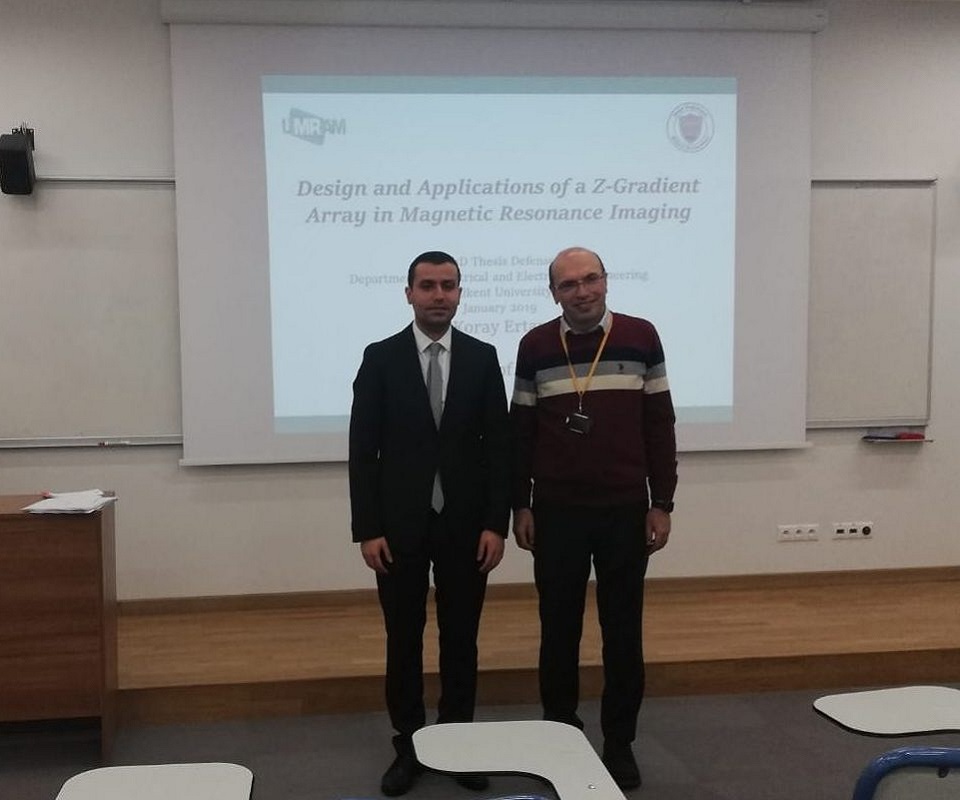Koray Ertan from UMRAM has successfully defended his Phd thesis.
He is currently enrolled in Electrical and Electronics PhD Program with his supervisor Ergin Atalar at Bilkent University.
He will continue his post-doc studies at Stanford University in following years.
Thesis Title: Design and Applications of A Z-Gradient Array in Magnetic Resonance Imaging.
Abstract: Array of gradient coils driven by independent power amplifiers can generate gradient fields with dynamically changing gradient field profiles. Nine channel prototype z-gradient coil array with a diameter of 25 cm is designed and manufactured. Previously designed gradient power amplifiers with maximum voltage of 50 V and maximum current of 20 A are used to independently drive the coils. Mutual coupling between gradient coils are investigated to maintain high time fidelity in the gradient waveform. A first-order circuit model including the mutual couplings is provided to analytically calculate the input voltages and minimum achievable rise times for a given set of gradient array currents and amplifier limitations. Mutual impedance of the system is measured which is in a good agreement with the first order circuit model inside the operating bandwidth of the amplifiers (<10kHz). An example z-gradient profile is optimized and used in Magnetic Resonance Imaging
(MRI) phantom experiment as a readout gradient. After validating the proper functioning of the hardware with current measurements and MRI experiments, advantages of dynamically arrangeable field profiles generated by z-gradient array are investigated.
Firstly, linear gradient in variable Volume of Interests (VOIs) with variable linearity errors are optimized with four different performance parameters such as maximization of gradient strength for unit amplifier current limits, maximization of slew rate for unit amplifier voltage limits, minimization of current norm and peak vector B-field for a unit gradient strength. Decreasing the size of the gradient VOI and allowing more linearity error increases all performance parameters more than five times among the sweep ranges. The advantage of dynamic field optimization is demonstrated in Diffusion Weighted Imaging (DWI).
Maximization of gradient fields only inside the slice volume rather than entire coil volume results in 4 times higher gradient strength which decreases the diffusion encoding gradient duration 3 times and halves the echo time. Increased signal to noise ratio (SNR) of the diffusion weighted images results in better estimate for the apparent diffusion coefficient (ADC) values inside the phantom.
Secondly, gradient array is also capable of generating nonlinear gradient field distributions. In addition to many applications of nonlinear gradients in MRI, two novel applications based on nonlinear gradients are proposed. In the first application, nonlinear gradients are used to encode multiple slice locations to the same frequency.
Excitation of multiple slices is achieved with a single band radio frequency (RF) pulse in contrast to multi-band RF pulses with higher specific absorption rate (SAR) and peak power. Two different field design method is presented and both of them are analyzed in terms of slice thickness error, center location variation, gradient strength per unit norm current, power dissipation. Two and three slices are excited with a single band RF pulse in phantom experiments. In the second application, a single channel nonlinear gradient field is simultaneously used with linear gradients during spoke excitation to mitigate the B1+ inhomogeneity. Excitation k-space with increased dimension are introduced for simultaneous use of linear and nonlinear gradients by including independent k-space variables for nonlinear gradient channel.
Simulations are performed for 1D, 2D, RF power limited and RF power unlimited cases to demonstrate the enhanced B1+ homogeneity for simultaneous use of linear and nonlinear gradients compared to using only linear or only nonlinear gradients. Proposed method results in 2.3 times more decrease in the excitation inhomogeneity compared to using only linear gradients in MRI experiments.
